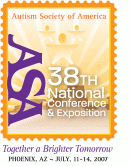 |
The ASA's 38th National Conference on Autism Spectrum Disorders (July 11-14, 2007) of ASAThe Westin Kierland Resort & Spa, Scottsdale, AZ |
| For a complete author index with session numbers, please click here | |
| Thursday, July 12, 2007: 1:15 PM-2:30 PM | |||
| Rainmakers Ballroom C | |||
| #2853- The Council on Quality and Leadership (CQL): Personal Outcome Measures and Learning about and Measuring Personal Definitions of Quality of Life* | |||
| The Council on Quality and Leadership (CQL) introduced Personal Outcome MeasuresSM in the early 1990ís and has applied them extensively for over a decade. Personal Outcome MeasuresSM 2005 Edition focuses on the choices people have in their lives, which serve as a powerful tool for evaluating the quality of life for people and the degree to which the organization individualizes supports to facilitate outcomes. People define outcomes for themselves. The outcomes are non-prescriptive; they have no norms. Each person is a sample of one. The meaning and definition of personal outcome items will vary from person to person. Personal Outcome MeasuresSM puts listening to, and learning from, the person at the center of organizational life. Personal Outcome MeasuresSM enables us to learn about people in new and different ways, guide person-directed planning and identify peopleís priorities. | |||
| Presenter: | - Beth Mathis has worked for CQL since 2003. She has a BA in Psychology from The University of the South,Sewanee, Tennessee, and a MA in Behavioral Science from The University of Houston, Clear Lake, Texas. She has a broad range of experience including direct support, assessment, support coordination, program development and administration, staff training, and quality enhancement. Prior to working for CQL, Ms. Mathis used The Personal Outcome Measures extensively in her position as the Quality Improvement Coordinator for community center in Texas. She is currently involved in marketing, project management, training and consultation provided to organizations and state systems. | ||
|
| |||
|
The Council on Quality and Leadership (CQL) introduced Personal Outcome MeasuresSM in the early 1990's as the first statistically valid and reliable tool to measure personal quality of life. Since then, CQL has applied this tool extensively in its work with organizations around efforts to improve the quality of their services and supports. Personal Outcome MeasuresSM are the heart of all CQL's quality strategies including Accreditation, Training, Data Analysis, Basic Assurances Certification as well as others. Personal Outcome MeasuresSM 2005 Edition focuses on the choices people have in their lives, which serve as a powerful tool for evaluating the quality of life for people and the degree to which the organization individualizes supports to facilitate outcomes. People define outcomes for themselves. The outcomes are non-prescriptive; they have no norms. Each person is a sample of one. The meaning and definition of personal outcome items will vary from person to person. Personal Outcome MeasuresSM puts listening to, and learning from, the person at the center of organizational life. Personal Outcome MeasuresSM enables us to learn about people in new and different ways, guide person-directed planning and identify people's priorities. Personal Outcome MeasuresSM 2005 edition help redefine the measurement of personal quality of life in the context of community. During this session, participants will learn about how Personal Outcome MeasuresSM can be used to learn about people's priorities and be applied in the discovery phase of planning for supports. They will also learn about how the outcomes can be used to measure the effectiveness of organizational structure in designing person directed services and supports. The 21 outcomes cover three areas of people's lives: My Self: The first factor is My Self, which can be described as who someone is as a result of their unique heredity, life experiences and decisions. 1.People are connected to natural supports. 2. People have intimate relationships. 3. People are safe. 4. People have the best possible health. 5. People exercise rights. 6. People are treated fairly. 7. People are free from abuse and neglect. 8. People experience continuity and security. 9. People decide when to share personal information. My World: My world can be summarized as where people work, socialize, belong or connect. 1. People choose where and with whom they live. 2. People choose where they work. 3. People use their environments. 4. People live in integrated environments. 5. People interact with other members of the community. 6. People perform different social roles. 7. People choose services. My Dreams: The last factor is My Dreams. My Dreams can best be described as how people want their life, self and world to be. 1. People choose personal goals. 2. People realize goals. 3. People participate in the life of the community. 4. People have friends. 5. People are respected. Personal Outcomes MeasuresSM are universal. They can be used by organizations to help redefine the context for measuring quality and support all people to live as members of their communities, rather than just as members of an organization. It is about utilizing the options and resources available, both within the organization and the community, to support people in achieving their desired quality of life. |
|||
See more of General Submissions
See more of The ASA's 38th National Conference on Autism Spectrum Disorders (July 11-14, 2007)